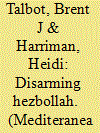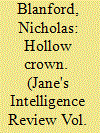| Srl | Item |
| 1 |
ID:
085300


|
|
|
|
|
| Publication |
2008.
|
| Summary/Abstract |
Hezbollah has become a powerful yet destabilizing force in Lebanon, affecting internal stability, allowing Syria and Iran dangerous influence, delaying peace with Israel, and complicating the Israeli-Palestinian conflict. Moreover, it forces the United States to struggle between traditional support for Israel and newfound support for Lebanese democracy. The international community should capitalize on Hezbollah's damaged public image following its 2006 war with Israel and pursue a multiparty disarmament effort, to include incentives for the major regional players. The effort should address Hezbollah's continued presence in the Lebanese Parliament, international support for the Lebanese Armed Forces, return of the Golan to Syria in exchange for its cutting military support to Hezbollah, and a nonaggression agreement between Israel and Lebanon.
|
|
|
|
|
|
|
|
|
|
|
|
|
|
|
|
| 2 |
ID:
139701


|
|
|
| 3 |
ID:
163258


|
|
|
|
|
| Summary/Abstract |
Iran has steadily expanded its strategic influence across the Middle East in large part due to its cultivation of a network of foreign co-religionist militant clients. Those clients have enabled Iran to fight adversaries by proxy in Iraq, Syria and Yemen. Iran's growing regional influence is often credited to the shared religious ties and loyalties of its clients. This article challenges that notion by examining Iran's post-1979 track record of developing clients and argues that, although Iran's successes—such as Lebanon's Hezbollah and Iraq's Badr—are well known, its failures to develop or retain the loyalty of clients have received much less attention. This article finds that Iran's relations with its clients are strongest when three conditions exist: first, those clients share Iran's theocratic interpretation of Shi'a Islam; second, Iran is the sole patron or the leading outside source of support to the client; and third, the client either shares or does not oppose Iran's ambitions in its country and agenda in the region. In cases when all those factors are present, Iran has been successful at preserving strong ties with clients over time. However, if one of those conditions is absent, then Iran's ties to a client can be susceptible to weakening and outside competition. These findings have important implications for the future of Iranian influence in the region and the Middle East more broadly.
|
|
|
|
|
|
|
|
|
|
|
|
|
|
|
|
| 4 |
ID:
100506


|
|
|
| 5 |
ID:
137382


|
|
|
|
|
| Summary/Abstract |
It is often assumed that Herat is a backwater in Afghanistan's national politics. Many consider it to be merely a conduit for Iranian influence, and that it doesn't have the relevance of provinces such as Kandahar or Helmand. This analysis challenges these assumptions. The article looks at Herat's place in Afghan politics over the period from 1978 to 2014, with specific and detailed reference to the anti-Soviet 1979 uprising, examining the influence that actors such as the USSR, Iran, Peshawar and various mujahedeen factions have attempted to bring to bear on the city, and focusing on how despite these pressures the city has in many ways been a self-directed and autonomous player, often setting the lead in terms of Afghan national politics. Herat and Kabul relations have frequently been marked by suspicion, but the author argues that Herat is still an integrated part (even if not well integrated) of the Afghan polity, and its troubled relations with Kabul are of more moment than its relationship with Tehran.
|
|
|
|
|
|
|
|
|
|
|
|
|
|
|
|